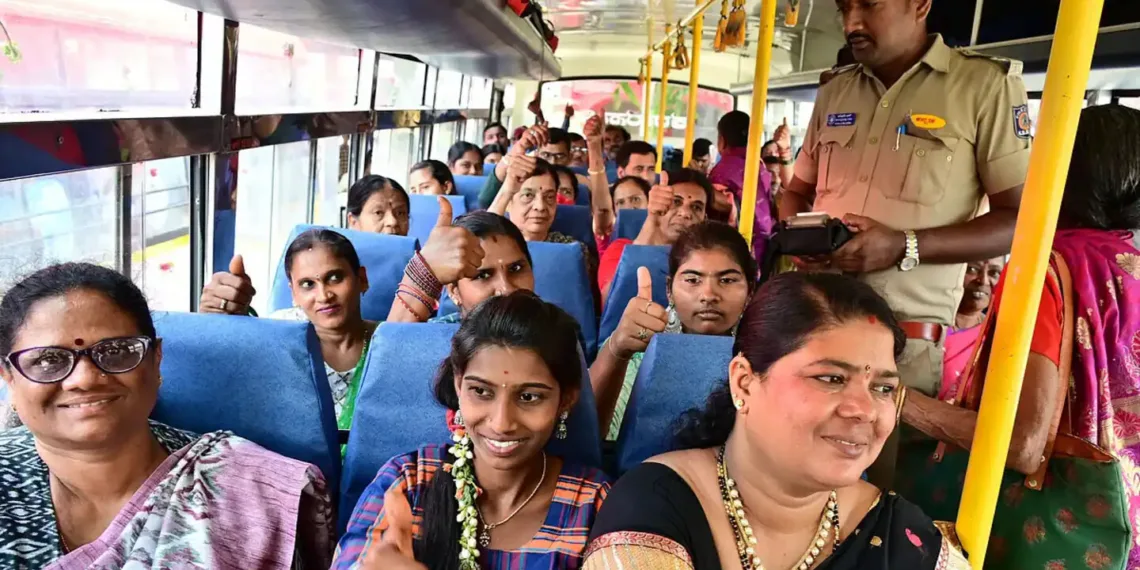Karnataka‘s groundbreaking Shakti Scheme has emerged as a powerful catalyst for women’s economic empowerment, with recent reports indicating a remarkable 23% increase in women’s employment in Bengaluru. This free bus travel initiative is transforming not just transportation but the very fabric of gender equality in India’s Silicon Valley.
Table of Contents
Karnataka Shakti Scheme: Key Performance Metrics
| Impact Areas | 2025 Results |
|---|---|
| Women’s Employment Growth | 23% increase in Bengaluru |
| Scheme Launch | June 2023 |
| Daily Ridership | Over 2 million women |
| Annual Savings per Woman | ₹15,000-20,000 |
| Total Beneficiaries | 3.2 crore women statewide |
| Transport Corporations Covered | KSRTC, BMTC, NWKRTC, NEKRTC |
| Annual Government Investment | ₹5,000+ crore |
| Employment Sectors Benefited | IT, Healthcare, Manufacturing, Services |
Breaking Down Transportation Barriers
The Shakti program provides free bus passes for women and transgender residents, marking a bold step towards just mobility and inclusion. This initiative has fundamentally changed how women access employment opportunities across Karnataka’s urban centers.

The scheme’s impact extends far beyond mere cost savings. By eliminating transportation costs, women can now:
- Accept jobs in distant locations previously deemed economically unviable
- Pursue higher-paying opportunities without transport cost concerns
- Invest saved money in skill development and education
- Experience greater financial independence and decision-making power
For comprehensive analysis of women’s workforce participation trends, explore our detailed employment statistics guide.
Economic Empowerment Through Mobility
The 23% employment surge represents more than statistics—it’s a testament to how transportation accessibility directly correlates with economic opportunities. The female labour force participation rate in Karnataka (2020-2021) was 25.1% compared to 57.5% of eligible men, highlighting the significant gender gap this scheme aims to address.
Key Employment Sectors Benefiting:
- Information Technology: Increased participation in Bengaluru’s tech hubs
- Healthcare Services: More women joining hospitals and clinics
- Manufacturing: Growth in garment and electronics sectors
- Service Industries: Retail, hospitality, and financial services
Financial Impact and Government Investment
The scheme permits women to travel free of cost on government-run buses within Karnataka, applicable on non-premium services such as KSRTC, BMTC, and other state-run buses. This comprehensive coverage ensures maximum accessibility across urban and rural areas.
The government’s substantial investment of over ₹5,000 crore annually demonstrates its commitment to gender equality and economic inclusion. This investment generates multiple returns:
- Increased tax revenue from higher women’s employment
- Reduced household poverty levels
- Enhanced economic productivity
- Improved social indicators
Learn more about government welfare schemes impacting employment in our comprehensive policy analysis.

Urban Transformation and Social Change
Bengaluru’s transformation showcases how progressive transportation policies can reshape urban demographics. The city has witnessed:
Workplace Diversity: Companies report increased gender diversity as women can commute from wider geographical areas.
Skill Development: Women are investing transport savings in professional courses and certifications.
Entrepreneurship Growth: Reduced travel costs enable women to explore business opportunities across the city.
Educational Access: Female students can pursue higher education in distant institutions without financial barriers.
Challenges and Implementation Success
Despite remarkable success, the scheme faces several operational challenges:
Infrastructure Strain: Increased ridership has put pressure on existing bus capacity, requiring fleet expansion and route optimization.
Quality Concerns: Maintaining service quality while managing higher passenger volumes remains an ongoing challenge.
Budget Sustainability: Long-term financing strategies are crucial for scheme continuity.
However, the government has responded proactively by investing in electric buses, expanding routes, and improving service frequency.
For insights into urban transportation planning, check our smart city mobility solutions guide.
Ripple Effects Across Industries
The employment surge has created positive ripple effects across various sectors:
IT Sector: Tech companies report improved talent acquisition from diverse geographical areas, enhancing innovation and productivity.
Healthcare: Hospitals and clinics have access to a larger pool of qualified female professionals, improving service delivery.
Manufacturing: Garment and electronics manufacturers benefit from increased female workforce participation, traditionally strong in these sectors.
National Implications and Replication Potential
Karnataka’s success has sparked interest from other states considering similar initiatives. The model demonstrates how targeted transportation policies can:
- Bridge gender employment gaps effectively
- Generate economic returns exceeding investment costs
- Create sustainable social change
- Improve overall urban mobility
Several states are now studying Karnataka’s implementation strategy for potential replication.
Stay updated with the latest developments in women’s empowerment initiatives through our gender equality news section.
Future Outlook and Expansion Plans
The Karnataka government plans to enhance the scheme further by:
- Expanding to premium bus services
- Integrating with metro and suburban rail networks
- Adding safety features and dedicated women’s sections
- Implementing digital payment systems for seamless travel
These enhancements aim to sustain the employment growth momentum while improving overall user experience.
For the latest updates on Karnataka’s development initiatives and women’s empowerment programs, visit TechnoSports. Official information about the Shakti Scheme is available through the Karnataka Transport Department.
FAQs
Q: How has Karnataka’s Shakti Scheme specifically contributed to the 23% increase in women’s employment?
A: The Shakti Scheme eliminates transportation costs, which previously prevented many women from accepting jobs in distant locations. By providing free bus travel, women can now access employment opportunities across Bengaluru without financial constraints, leading to a 23% surge in female workforce participation. The scheme saves each woman approximately ₹15,000-20,000 annually, money that can be reinvested in skill development and education.
Q: Which transportation services are covered under the Shakti Scheme, and who is eligible?
A: The scheme covers all government-run bus services including KSRTC, BMTC, NWKRTC, and NEKRTC across Karnataka. All female citizens and transgender residents of Karnataka are eligible regardless of age or income level. The scheme applies to non-premium bus services and has benefited over 3.2 crore women statewide since its launch in June 2023.








